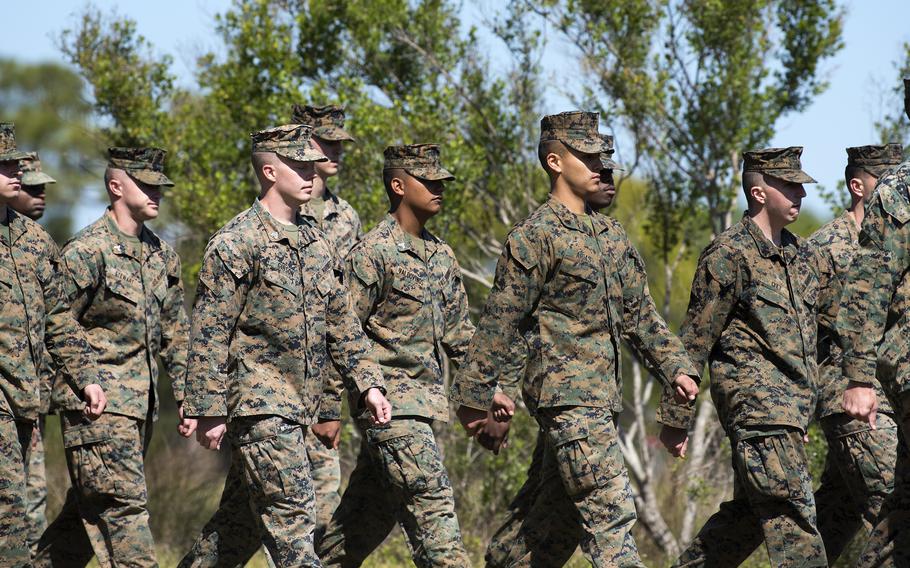
Marines practice marching during a field exercise at MacDill Air Force Base, Fla., in March 2018. (Caleb Nunez/U.S. Air Force)
WASHINGTON — The Navy and Marine Corps are gearing up for a global training exercise in August, service officials said Monday.
“In the post-Cold War era and during the Global War on Terrorism, the seas were relatively uncontested,” Navy Capt. Chris Narducci said. “We were able to operate where we wanted to. A lot of times we did so statically, remaining in the same location and conducting the same operations day in and day out. We were not threatened. However, times have changed.”
Large Scale Exercise 2023 is the second time since 2021 that training has been conducted between the two service branches, Adm. Daryl Caudle said during a discussion with reporters. He said the exercise builds on things that the Navy has been working on for the last five years, focusing on local and tactical testing of new capabilities and then packaging them for U.S. Fleet Forces and Pacific Fleet Commands.
“The amount of military capacity and capability will be strained in any conflict with a competitor. The ability to synchronize is extremely important,” Caudle said. “To conduct high-end modern warfare and to distribute it … you have to work on precision and timing. To do that, you’ve got to link together these maritime operation centers.”
The Defense Department released its National Defense Strategy in October, the first time in four years. The strategy is a comprehensive security assessment that identifies China, Russia, North Korea, Iran — and climate change — as some of the top threats for which the U.S. military is preparing.
While the strategy identifies several potential threats, it calls China the chief competitor for the United States. It also identifies Russia as an “acute” threat.
Narducci, lead planner for the exercise, said the training will take place with live, virtual and constructive components across 22 time zones. It will include six combatant command centers — Indo-Pacific, Northern Command, Southern Command, Europe, Africa and some of Central Command in the Middle East.
“We want to build a more competent and lethal force. We want to be able to demonstrate that we can globally synchronize this exercise,” he said.
More than 25,000 sailors and Marines will participate, along with 1,080 personnel running control scenarios. The Naval Warfare Development Center at Naval Air Station in Norfolk, Va., will be the exercise center and supported by six global control nodes, Narducci said.
Military officials have made it clear that the Indo-Pacific region is a top priority.
In January, Defense Secretary Lloyd Austin along with Japanese defense minister Yasukazu Hamada, Secretary of State Antony Blinken and Japanese foreign minister Yoshimasa Hayashi reached an agreement for both countries to strengthen military and security cooperations in the region.
The leaders said the driving force for the new arrangements boils down to making it easier for Washington and Tokyo to uphold rules-based order in the Indo-Pacific, a region that has taken on increased importance in recent years due to tension over the sovereignty of Taiwan and provocative Chinese actions in the South China Sea.
“We agree that [China] is the greatest shared strategic challenge,” Blinken said. “Our alliance has never been more crucial to realizing a shared vision for a free and open Indo-Pacific.”
Adm. John Aquilino, commander of Indo-Pacific Command, told lawmakers in April that he is seeking to build a network of like-minded nations in the region that will stand as a bulwark against aggression by China and North Korea. The U.S. has regional treaty alliances with Japan, South Korea, the Philippines, Australia and Thailand and is looking to pull in additional allies through military exercises and other engagements.
The range and components of the exercise includes:
• 22 time zones.
• 6 combatant command areas.
• 9 maritime operation centers.
• 2nd, 3rd, 4th, 5th, 6th, 7th and 10th fleets will participate.
• 6 carrier strike groups, 2 live and 4 virtual.
• 3 amphibious readiness groups, 1 live and 2 virtual.
• 25 ships and submarines, more than 50 virtual.
• More than 25,000 sailors and Marines.
• 1,080 personnel running control scenarios.
• 15 supporting flag and general officers, active and retired.